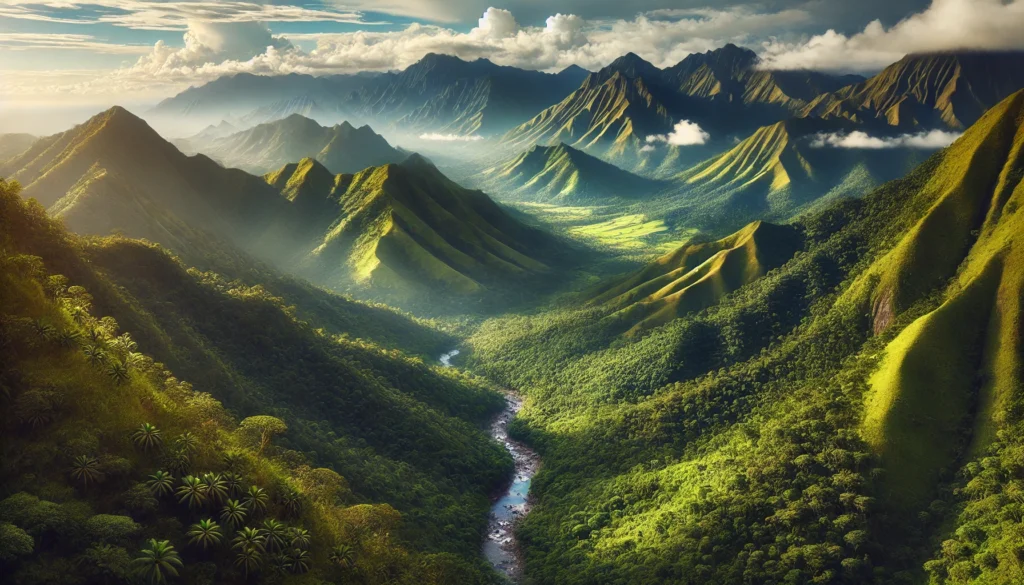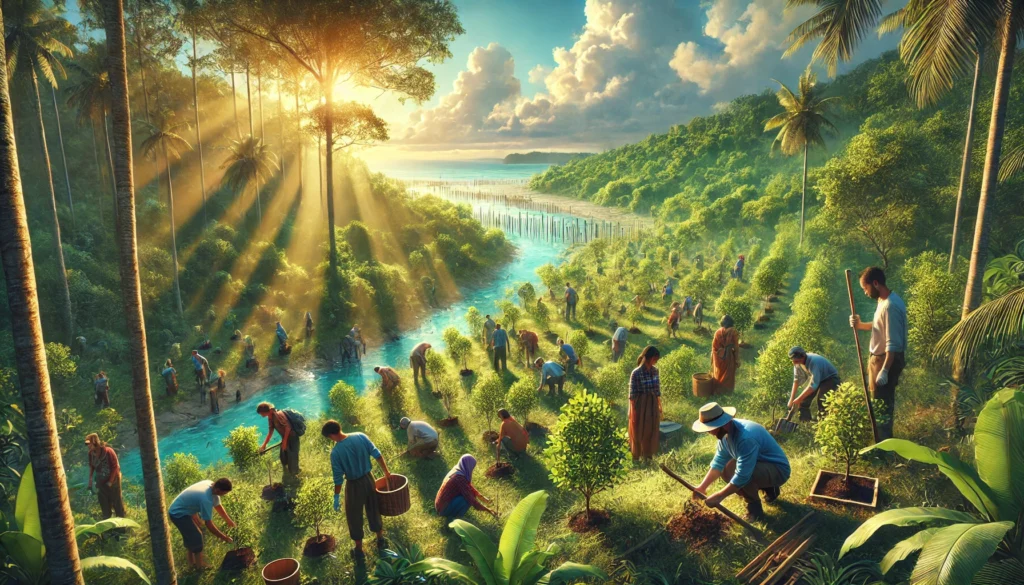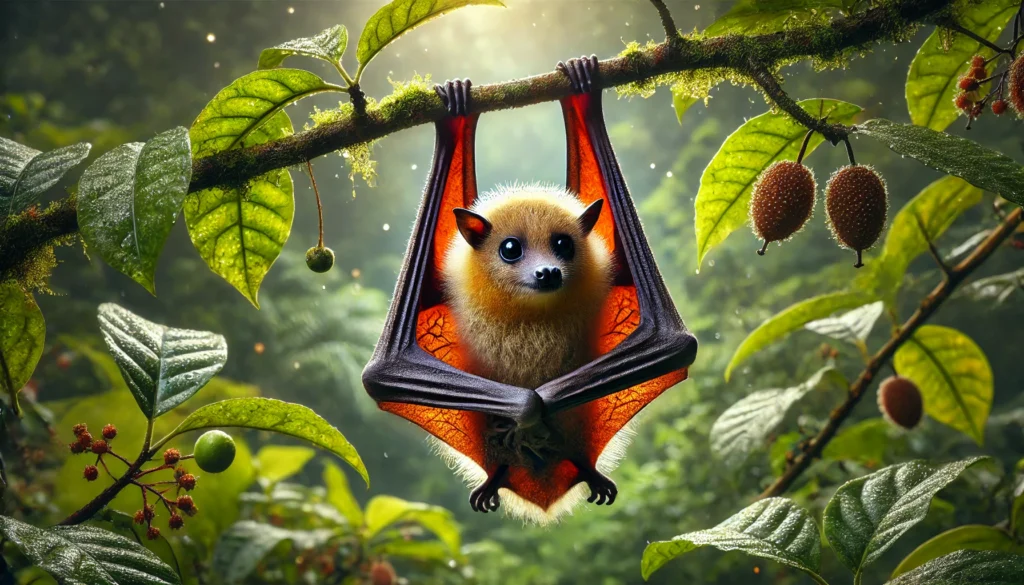Welcome, dear reader, to a journey through the magnificent Sierra Madre Mountain Range – the unsung hero of the Philippines! Imagine a mountain range so impressive, it makes the Rockies look like speed bumps. Okay, maybe that’s a slight exaggeration, but hear me out. The Sierra Madre is not just any old pile of rocks; it’s the longest mountain range in the Philippines, stretching over 540 kilometers along the eastern coast of Luzon. That’s longer than the distance between New York City and Washington D.C.! But unlike those two cities, the Sierra Madre doesn’t have traffic jams or overpriced coffee shops. Instead, it’s home to a dizzying array of flora and fauna, some of which are found nowhere else on Earth. It’s like Mother Nature’s own exclusive club, where only the coolest plants and animals get VIP access. But before we dive deeper into this green giant’s secrets, let’s take a moment to appreciate its sheer size and importance. The Sierra Madre isn’t just a pretty face; it’s the backbone of Luzon, literally and figuratively. It protects the island from typhoons, provides water to millions, and harbors some of the most pristine forests left in the country. So buckle up, nature enthusiasts and geography nerds, because we’re about to embark on a wild ride through the Sierra Madre – no hiking boots required!
The Geography: A Mountain Range with Attitude
Size Matters: The Sierra Madre’s Impressive Stats
Let’s talk numbers, shall we? The Sierra Madre Mountain Range is like that overachiever in high school who excels at everything. It stretches across 10 provinces in Luzon, from Cagayan in the north to Quezon in the south. That’s right, it’s basically the spine of Luzon, holding the island together like a really long, rocky glue stick. But it’s not just long; it’s also impressively tall. The highest peak, Mount Anacuao, stands at a whopping 1,850 meters above sea level. That’s taller than 5 Eiffel Towers stacked on top of each other! And let’s not forget about its girth. At its widest point, the Sierra Madre spans 50 kilometers from east to west. That’s wider than some small countries! (Sorry, Monaco, but size does matter sometimes.)
A Geological Rollercoaster: The Sierra Madre’s Formation
Now, you might be wondering, “How did this mountain range get here? Did someone accidentally spill a giant bag of rocks?” Well, not quite. The Sierra Madre’s formation is a tale of geological drama that would put soap operas to shame. It all started millions of years ago when the Philippine Sea Plate decided to play a game of bumper cars with the Eurasian Plate. As these two tectonic plates collided, the land was pushed upwards, creating the mountain range we see today. It’s like when you push two slices of pizza together, and the toppings pile up in the middle – except this pizza took millions of years to make and is a lot less edible.
The Sierra Madre’s Many Faces: Diverse Landscapes
But the Sierra Madre isn’t just one big lump of rock. Oh no, it’s got more diversity than a United Nations meeting. From north to south, you’ll find a smorgasbord of landscapes that would make any geographer’s heart skip a beat. There are dense tropical rainforests that look like they’ve been plucked straight out of a Tarzan movie. You’ve got rugged peaks that seem to touch the sky, perfect for those “I’m on top of the world” Instagram shots (if you can make the climb, that is). And let’s not forget about the hidden valleys and pristine rivers that snake through the range like nature’s own waterpark. It’s like Mother Nature couldn’t decide on just one look, so she threw everything into the mix. The result? A mountain range with more personalities than a theater troupe.
Biodiversity Bonanza: Nature’s Treasure Trove
A Noah’s Ark of Species: The Sierra Madre’s Incredible Biodiversity
If Noah had built his ark in the Philippines, he probably would have docked it in the Sierra Madre. This mountain range is a veritable Noah’s Ark of biodiversity, hosting an astonishing array of plant and animal species. We’re talking about more than 3,000 plant species, 300 bird species, and countless other critters calling this place home. It’s like a real-life Pokémon game, but instead of catching them all, we’re trying to protect them all. And just like in Pokémon, some of these species are incredibly rare and found nowhere else in the world. The Sierra Madre is home to the Philippine Eagle, also known as the Monkey-eating Eagle (don’t worry, they don’t actually eat monkeys… much). This majestic bird is so impressive, it makes bald eagles look like pigeons in comparison.
Endemics Galore: The Sierra Madre’s Unique Residents
But wait, there’s more! The Sierra Madre is also a hotspot for endemic species – that’s science-speak for “you won’t find these anywhere else, folks!” Let’s take a look at some of the Sierra Madre’s exclusive VIP (Very Important Plants and animals):
| Endemic Species | Fun Fact |
|---|---|
| Philippine Eagle | Has a wingspan of up to 2 meters – that’s wider than most people are tall! |
| Isabela Oriole | So elusive, it’s like the ninja of the bird world |
| Sierra Madre Shrew-rat | Proof that even rats can be fancy and exclusive |
| Rafflesia | A flower so big and smelly, it’s nicknamed the “corpse flower” |
| Sierra Madre Pitcher Plant | A carnivorous plant that’s like a tiny, vegetable Sarlacc pit |
These species are like the cool kids of the Sierra Madre, living in their exclusive ecological gated community. But unlike human gated communities, we actually want to preserve this one!
The Green Lung: Forest Cover and Its Importance
Now, let’s talk about the Sierra Madre’s lush forest cover. This isn’t just any old bunch of trees; it’s the green lung of Luzon, breathing life into the entire region. As of 2020, the Sierra Madre still boasted significant forest cover, with estimates ranging from 1.4 million to 1.7 million hectares of forest. That’s about 2.4 million football fields worth of trees! This forest acts like a giant sponge, soaking up rainfall and releasing it slowly into rivers and streams. It’s nature’s own water filtration system, providing clean water to millions of people downstream. Plus, these forests are carbon-sequestering champions, gobbling up CO2 like it’s going out of style. In the fight against climate change, the Sierra Madre is like a heavyweight boxer in the ring, throwing punches at greenhouse gases left and right.
The Water Tower: Quenching Luzon’s Thirst
Watershed Wonderland: The Sierra Madre’s Hydrological Importance
If the Sierra Madre were a superhero, its superpower would be hydrology. This mountain range is the ultimate water tower, supplying freshwater to millions of people across Luzon. It’s home to major river systems that sound like they were named by a fantasy novelist: the Cagayan River, the Agno River, the Pampanga River, and more. These rivers aren’t just pretty blue lines on a map; they’re the lifeblood of the region, providing water for drinking, irrigation, and even electricity generation. The Sierra Madre is basically nature’s own plumbing system, and it doesn’t even charge for maintenance!
Dams and Reservoirs: Harnessing the Sierra Madre’s Aquatic Bounty
Humans, being the clever monkeys we are, have found ways to make the most of this watery wealth. The Sierra Madre is home to several major dams and reservoirs that help manage this precious resource. Let’s take a look at some of these aquatic marvels:
| Dam/Reservoir | Location | Purpose |
|---|---|---|
| Angat Dam | Bulacan | Supplies 90% of Metro Manila’s water needs |
| Pantabangan Dam | Nueva Ecija | Irrigation and hydroelectric power |
| Magat Dam | Isabela | Flood control and irrigation |
| La Mesa Dam | Quezon City | Water supply for Metro Manila |
These dams are like giant bathtubs, holding back millions of cubic meters of water. But unlike your bathtub, if these overflow, it’s a bit more serious than just a wet bathroom floor.
The Typhoon Shield: How the Sierra Madre Protects Luzon
But wait, there’s more! The Sierra Madre isn’t just a water dispenser; it’s also nature’s own typhoon shield. When tropical cyclones come barreling in from the Pacific, the Sierra Madre stands tall like a bouncer at an exclusive club, saying, “Sorry, typhoon, you’re not on the list.” Its high peaks force the storms to release much of their rainfall on the eastern slopes, significantly weakening them before they reach the populous western regions of Luzon. It’s like the Sierra Madre is playing goalie, blocking shots from Mother Nature herself. So the next time you hear about a typhoon weakening as it crosses Luzon, give a little thanks to the Sierra Madre – it’s probably saved you from having to buy a new umbrella.
The Human Element: Communities and Conservation
Indigenous Peoples: The Original Guardians of the Sierra Madre
Now, let’s talk about the human side of the Sierra Madre. This mountain range isn’t just home to exotic plants and animals; it’s also the ancestral domain of several indigenous groups. These include the Agta, Dumagat, and Remontado peoples, who have lived in harmony with the forest for generations. They’re like the original park rangers, but without the funny hats. These communities have a deep connection to the land, with traditions and practices that have helped preserve the Sierra Madre’s biodiversity. They know the forest like the back of their hand – which is impressive, considering how big the forest is and how small hands are in comparison.
Conservation Efforts: Battling to Protect the Green Giant
But as Bob Dylan once sang, “The times, they are a-changin’,” and not always for the better. The Sierra Madre faces numerous threats, from illegal logging to mining to land conversion. It’s like the mountain range is playing a real-life game of Whac-A-Mole, with new challenges popping up faster than you can say “environmental degradation.” Thankfully, there are numerous conservation efforts underway to protect this vital ecosystem. Organizations like the Haribon Foundation and the Sierra Madre Biodiversity Corridor Program are working tirelessly to preserve the Sierra Madre’s natural wealth. They’re like the Avengers of environmental protection, but with more paperwork and fewer CGI explosions.
Ecotourism: Enjoying Nature Responsibly
One way to help protect the Sierra Madre while also enjoying its beauty is through ecotourism. Several areas within the mountain range have been developed for responsible tourism, allowing visitors to experience the wonders of the Sierra Madre without leaving a Bigfoot-sized carbon footprint. You can go birdwatching in the Northern Sierra Madre Natural Park, trek through the lush forests of Quezon, or raft down the pristine rivers of Nueva Ecija. It’s like going on a treasure hunt, but instead of gold, you’re searching for rare birds and plants. And unlike other treasure hunts, you’re supposed to leave everything exactly where you found it.
Challenges and Threats: The Sierra Madre’s Nemeses
Deforestation: The Silent Killer
Now, let’s talk about the elephant in the room – or rather, the chainsaw in the forest. Deforestation has been a significant threat to the Sierra Madre for decades. Despite its protected status, illegal logging continues to nibble away at the edges of this green giant. It’s like a really slow, really destructive game of Pac-Man, with trees instead of dots. According to data from the Department of Environment and Natural Resources, the Philippines lost about 7.2 million hectares of forest cover between 1934 and 2020, with a significant portion of that loss occurring in the Sierra Madre. That’s an area larger than the entire country of Ireland! At this rate, leprechauns might have more forests to hide in than the Sierra Madre.
Climate Change: The Global Threat
But it’s not just local threats that the Sierra Madre has to worry about. Climate change is like that annoying party guest who shows up uninvited and ruins everything for everyone. Rising temperatures and changing rainfall patterns are already affecting the delicate ecosystems of the Sierra Madre. Some species are being forced to move to higher elevations to escape the heat, like nature’s own version of a very slow, very high-stakes game of musical chairs. And with sea levels rising, the lower slopes of the Sierra Madre could face increased flooding and erosion. It’s as if Mother Nature decided to turn up the thermostat and left the faucet running at the same time.
Development Pressures: Progress at What Cost?
As the population grows and the demand for resources increases, the Sierra Madre faces increasing pressure from development projects. New roads, mines, and agricultural expansions are encroaching on the mountain range’s territories. It’s like a game of Monopoly, but instead of hotels on Boardwalk, we’re talking about banana plantations in prime forest land. While development is important for the country’s economy, finding a balance between progress and preservation is crucial. After all, what good is a booming economy if we don’t have clean air to breathe or water to drink?
The Future: Hope on the Horizon
Conservation Initiatives: Fighting the Good Fight
Despite the challenges, there’s still hope for the Sierra Madre. Numerous conservation initiatives are underway, combining the efforts of government agencies, NGOs, and local communities. The National Greening Program, launched in 2011, aimed to plant 1.5 billion trees covering 1.5 million hectares by 2020. While the program faced its share of challenges, it represented a significant step towards reforestation. Additionally, projects like the Sierra Madre Biodiversity Corridor seek to connect fragmented forest areas, creating wildlife highways that would make any city traffic planner jealous. These efforts are like ecological stitches, sewing back together the torn fabric of the Sierra Madre’s ecosystems.
Education and Awareness: Knowledge is Power
One of the most powerful tools in the fight to protect the Sierra Madre is education. By raising awareness about the importance of this mountain range, we can create a new generation of environmental stewards. Schools across the Philippines are incorporating environmental education into their curricula, teaching students about the value of biodiversity and the need for conservation. It’s like planting seeds of knowledge that will grow into mighty oaks of environmental consciousness. Or something like that – I might be mixing my metaphors, but you get the idea.
Sustainable Development: Having Our Cake and Eating It Too
The future of the Sierra Madre doesn’t have to be a choice between total preservation and uncontrolled development. Sustainable development practices offer a middle ground, allowing for economic growth while protecting the environment. This could include sustainable agriculture techniques, responsible ecotourism, and green energy projects that harness the Sierra Madre’s natural resources without depleting them. It’s like finding that perfect balance in a tightrope walk, except the rope is made of vines and the safety net is woven from endangered plant fibers.
The Sierra Madre – More Than Just a Mountain Range
As we come to the end of our journey through the Sierra Madre, it’s clear that this mountain range is so much more than just a collection of peaks and valleys. It’s a life-giver, a protector, a home to countless species, and a vital resource for millions of people. The Sierra Madre is like that quiet, unassuming friend who turns out to be a superhero in disguise. It doesn’t wear a cape or fly through the sky, but it battles against typhoons, provides water to the thirsty, and harbors more biodiversity than you can shake a stick at (although please don’t actually shake sticks at the wildlife).
Protecting the Sierra Madre is not just about preserving a pretty landscape. It’s about safeguarding our water supply, maintaining our climate stability, and ensuring that future generations can experience the wonder of this incredible ecosystem. It’s a task that requires the efforts of everyone – from government officials to local communities, from big corporations to individual citizens. Every time we choose to recycle, to support sustainable products, or to speak up for environmental protection, we’re casting a vote for the future of the Sierra Madre.
So the next time you take a sip of clean water, breathe in fresh air, or simply enjoy a sunny day without a typhoon in sight, take a moment to thank the Sierra Madre. It’s been working tirelessly for millions of years to make your life better, and it doesn’t even ask for a paycheck. The least we can do is try to return the favor by protecting this magnificent mountain range for generations to come.
Remember, in the story of the Philippines, the Sierra Madre isn’t just a setting – it’s one of the main characters. And like any good protagonist, it needs our support to overcome the challenges it faces. So let’s all be the sidekicks in this environmental adventure story. After all, every superhero needs a good support team, and the Sierra Madre has been supporting us for longer than we can imagine. It’s time we returne




